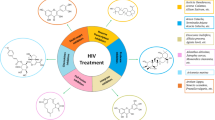Abstract
Acquired immunodeficiency syndrome patients face great socio-economic difficulties in obtaining treatment. There is an urgent need for new, safe, and cheap anti-HIV agents. Traditional medicinal plants are a valuable source of novel anti-HIV agents and may offer alternatives to expensive medicines in future. Various medicinal plants or plant-derived natural products have shown strong anti-HIV activity and are under various stages of clinical development in different parts of the world. The present study was directed towards assessment of anti-HIV activity of various extracts prepared from Indian medicinal plants. The plants were chosen on the basis of similarity of chemical constituents with reported anti-HIV compounds or on the basis of their traditional usage as immunomodulators. Different extracts were prepared by Soxhlet extraction and liquid–liquid partitioning. Ninety-two extracts were prepared from 23 plants. Anti-HIV activity was measured in a human CD4+ T-cell line, CEM-GFP cells infected with HIV-1NL4.3. Nine extracts of 8 different plants significantly reduced viral production in CEM-GFP cells infected with HIV-1NL4.3. Aegle marmelos, Argemone mexicana, Asparagus racemosus, Coleus forskohlii, and Rubia cordifolia demonstrated promising anti-HIV potential and were investigated for their active principles.

Similar content being viewed by others
References
Anonymous (2009) AIDS epidemic update. UNAIDS, Geneva
Yu D, Morris-Natschke SL, Lee KH (2007) New developments in natural products-based anti-AIDS research. Med Res Rev 27:108–132
Cos P, Maes L, Vlietinck A, Pieters L (2008) Plant-derived leading compounds for chemotherapy of human immunodeficiency virus (HIV) infection—an update (1998–2007). Planta Med 74:1323–1337
Bedoya LM, Sanchez-Palomino S, Abad MJ, Bermejo P, Alcami J (2001) Anti-HIV activity of medicinal plant extracts. J Ethnopharmacol 77:113–116
Min BS, Bae KH, Kim YH, Miyashiro H, Hattori M, Shimotohno K (1999) Screening of Korean plants against human immunodeficiency virus type 1 protease. Phytother Res 13:680–682
Min BS, Kim YH, Tomiyama M, Nakamura N, Miyashiro H, Otake T, Hattori M (2001) Inhibitory effects of Korean plants on HIV-1 activities. Phytother Res 15:481–486
Harkar S, Razdan TK, Waight ES (1984) Steroids, chromone and coumarins from Angelica officinalis. Phytochemistry 23:419–426
Sharma BR, Rattan RK, Sharma P (1981) Marmeline, an alkaloid, and other components of unripe fruits of Aegle marmelos. Phytochemistry 20:2606–2607
Chen IS, Lin YC, Tsai IL, Teng CM, Ko FN, Ishikawa T, Ishii H (1995) Coumarins and anti-platelet aggregation constituents from Zanthoxylum schinifolium. Phytochemistry 39:1091–1097
Iwasa K, Sugiura M, Takao N (1982) Stereochemistry of 13-hydroxyprotoberberines, their derivatives and a protopine-type alkaloid. J Org Chem 47:4275–4280
Anet FA, Brown MA (1967) The nuclear resonance spectrum of protopine: rate of racemization and ring inversion. Tetrahedron Lett 48:4881–4884
Guinaudeau H, Shamma M (1982) The protopine alkaloids. J Nat Prod 45:237–246
Jadhav AN, Bhutani KK (2006) Steroidal saponins from the roots of Asparagus adscendens Roxb and Asparagus racemosus Willd. Indian J Chem 45B:1515–1524
Kanakubo A, Koga K, Isobe M, Fushimi T, Saitoh T, Ohshima Y, Tsukamoto Y (2001) First finding of daidzein 7-O-phosphate and genistein 7-O-phosphate that are hydrolyzed by sulfatase. Tetrahedron 57:8801–8805
Bodiwala HS, Sabde S, Mitra D, Bhutani KK, Singh IP (2009) Anti-HIV diterpenes from Coleus forskohlii. Nat Prod Commun 4:1173–1175
Talapatra SK, Sarkar AC, Talapatra B (1981) Two pentacyclic triterpenes from Rubia cordifolia. Phytochemistry 20:1923–1927
Itokawa H, Qiao Y, Takeya K (1989) Anthraquinones and naphthohydroquinones from Rubia cordifolia. Phytochemistry 28:3465–3468
Tripathi YB, Sharma M, Manickam M (1997) Rubiadin, a new antioxidant from Rubia cordifolia. Indian J Biochem Biophys 34:302
Singh R, Geetanjali (2005) Isolation and synthesis of anthraquinones and related compounds of Rubia cordifolia. J Serb Chem Soc 70:937–942
Kumar M, Mitra D (2005) Heat shock protein 40 is necessary for human immunodeficiency virus-1 Nef-mediated enhancement of viral gene expression and replication. J Biol Chem 280:40041–40050
Bleicher KH, Bohm HJ, Muller K, Alanine AI (2003) Hit and lead generation: beyond high-throughput screening. Nat Rev Drug Discov 2:369–378
Singh IP, Bodiwala HS (2010) Recent advances in anti-HIV natural products. Nat Prod Rep 27:1781–1800
Singh IP, Bharate SB, Bhutani KK (2005) Anti-HIV natural products. Curr Sci 89:269–290
Patwardhan B, Gautam M (2005) Botanical immunodrugs: scope and opportunities. Drug Discov Today 10:495–502
Mishra BB, Singh DD, Kishore N, Tiwari VK, Tripathi V (2010) Antifungal constituents isolated from the seeds of Aegle marmelos. Phytochemistry 71:230–234
Zhou P, Takaishi Y, Duan H, Chen B, Honda G, Itoh M, Takeda Y, Kodzhimatov OK, Lee K-H (2000) Coumarins and bicoumarin from Ferula sumbul: anti-HIV activity and inhibition of cytokine release. Phytochemistry 53:689–697
Sancho R, Marquez N, Gomez-Gonzalo M, Calzado MA, Bettoni G, Coiras MT, Alcami J, Lopez-Cabrera M, Appendino G, Munoz E (2004) Imperatorin inhibits HIV-1 replication through an Sp1-dependent pathway. J Biol Chem 279:37349–37359
Tan GT, Pezzuto JM, Kinghorn AD, Hughes SH (1991) Evaluation of natural products as inhibitors of human immunodeficiency virus type 1 (HIV-1) reverse transcriptase. J Nat Prod 54:143–154
Chang YC, Hsieh PW, Chang FR, Wu RR, Liaw CC, Lee KH, Wu YC (2003) Two new protopines argemexicaines A and B and the anti-HIV alkaloid 6-acetonyldihydrochelerythrine from formosan Argemone mexicana. Planta Med 69:148–152
Yang XW, Zhao J, Cui YX, Liu XH, Ma CM, Hattori M, Zhang LH (1999) Anti-HIV-1 protease triterpenoid saponins from the seeds of Aesculus chinensis. J Nat Prod 62:1510–1513
Shan Y, Wang X, Zhou X, Kong L, Niwa M (2007) Two minor diterpene glycosides and an eudesman sesquiterpene from Coleus forskohlii. Chem Pharm Bull 55:376–381
Chang LC, Chávez D, Gills JJ, Fong HS, Pezzuto JM, Kinghorn AD (2000) Rubiasins A-C, new anthracene derivatives from the roots and stems of Rubia cordifolia. Tetrahedron Lett 41:7157–7162
Min BS, Miyashiro H, Hattori M (2002) Inhibitory effects of quinones on RNase H activity associated with HIV-1 reverse transcriptase. Phytother Res 16:S57–S62
Acknowledgment
The authors are grateful to Department of Biotechnology, Government of India for financial support to this project (Grant no. BT/PR7020/Med/14/930/2005 Date 23/05/2006).
Author information
Authors and Affiliations
Corresponding authors
Additional information
NIPER Communication No. 479.
Rights and permissions
About this article
Cite this article
Sabde, S., Bodiwala, H.S., Karmase, A. et al. Anti-HIV activity of Indian medicinal plants. J Nat Med 65, 662–669 (2011). https://doi.org/10.1007/s11418-011-0513-2
Received:
Accepted:
Published:
Issue Date:
DOI: https://doi.org/10.1007/s11418-011-0513-2




